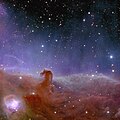Fichier:Euclid’s view of the Horsehead Nebula ESA25170866.jpg

Taille de cet aperçu : 600 × 600 pixels. Autres résolutions : 240 × 240 pixels | 480 × 480 pixels | 768 × 768 pixels | 1 024 × 1 024 pixels | 2 048 × 2 048 pixels | 8 200 × 8 200 pixels.
Fichier d’origine (8 200 × 8 200 pixels, taille du fichier : 1,84 Mio, type MIME : image/jpeg)
Historique du fichier
Cliquer sur une date et heure pour voir le fichier tel qu'il était à ce moment-là.
| Date et heure | Vignette | Dimensions | Utilisateur | Commentaire | |
|---|---|---|---|---|---|
| actuel | 7 novembre 2023 à 20:50 |  | 8 200 × 8 200 (1,84 Mio) | OptimusPrimeBot | #Spacemedia - Upload of https://www.esa.int/var/esa/storage/images/esa_multimedia/images/2023/11/euclid_s_view_of_the_horsehead_nebula/25170855-1-eng-GB/Euclid_s_view_of_the_Horsehead_Nebula.jpg via Commons:Spacemedia |
Utilisation du fichier
Les 34 pages suivantes utilisent ce fichier :
- Euclid (télescope spatial)
- IC 434
- Utilisateur:Armael
- Utilisateur:Cimosteve
- Utilisateur:GaetanSpace
- Utilisateur:LoganEspeon
- Utilisateur:Mikani/Archive/wikimag
- Utilisateur:Urban
- Discussion utilisateur:Aeleftherios/Archives 2008
- Discussion utilisateur:Blue02
- Discussion utilisateur:Cattzy
- Discussion utilisateur:Croquant/Archive2
- Discussion utilisateur:Delhovlyn/Archive (2)
- Discussion utilisateur:Elfix/Archives/01 Avril-fin octobre 2008
- Discussion utilisateur:Futon
- Discussion utilisateur:H du Viala
- Discussion utilisateur:La Cigale/Bac à gravier
- Discussion utilisateur:Lvcvlvs
- Discussion utilisateur:Mikani/2008
- Discussion utilisateur:Nanoxyde/Archives 04
- Discussion utilisateur:Otourly/Archive 2
- Discussion utilisateur:Paulokoko
- Discussion utilisateur:Riba/Archive 2
- Discussion utilisateur:Rvince
- Discussion utilisateur:Salix/Archives 2e semestre 2008
- Discussion utilisatrice:Tella/Archive 6
- Discussion utilisateur:Thesupermat/Archive2
- Discussion utilisateur:WikiDreamer
- Discussion utilisateur:Xfigpower/Archive2008 S2
- Discussion utilisateur:Yodie/Septembre 2007 - Septembre 2009
- Discussion utilisateur:Zouavman Le Zouave/Archive (4)
- Wikipédia:Image du jour/1 mai 2024
- Wikipédia:Image du jour/mai 2024
- Wikipédia:Wikimag/2024/18
Usage global du fichier
Les autres wikis suivants utilisent ce fichier :
- Utilisation sur he.wikipedia.org
- Utilisation sur ru.wikipedia.org
- Utilisation sur vi.wikipedia.org





